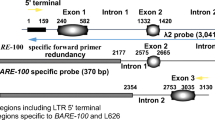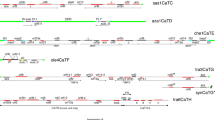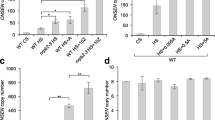Abstract
The study of two variable amplicons of rye indicates that RYS1, a mobile element, is activated during tissue culture. We propose that RYS1 could be a foldback (FB) transposon. The FB transposons have been rarely reported in plants; RYS1 is the first described in rye and also the first active plant FB transposon reported. Preferential integration points in the rye genome exist, because the new insertions seem to be located, in all studied cases, in the same genome positions. We assume that RYS1 became active in rye very recently, as different plants from in vivo-growing cultivars showed that these elements were present or absent in the same genomic position in which the in vitro-activated element was found. This high rate of modification in these particular loci, both in the in vivo and in vitro populations, could indicate that probably the mechanisms promoting genetic variability in nature are the same that induce variation in vitro, and the modifications induced by somaclonal variation could be already present in vivo populations




Similar content being viewed by others
References
Chandler VL,Vaucheret H (2001) Gene activation and genetic silencing. Plant Physiol 125:145–148
Casacuberta JM, Santiago N (2003) Plant LTR-retrotransposons and MITEs: control of transposition and impact on the evolution of plant genes and genomes. Gene 311:1–11
Collins M, Rubin GM (1983) High-frequency precise excision of the Drosophila foldback transposable element. Nature 303:259–260
Dellaporta SL, Wood J, Hicks JB (1983) A plant DNA minipreparation: version II. Plant Mol Biol Rep 1:19–21
Dietrich CR, Cui F, Packila ML, Li J, Ashlock DA, Nikolau BJ, Schnnable PS (2002) Maize Mu transposons are targeted to the 5′ untranslated region of the gl8 gene and sequences flanking Mu target-site duplications exhibit nonrandom nucleotide composition throughout the genome. Genetics 160:697–716
Feschotte C, Jiang N, Wessler SR (2002) Plant transposable elements: where genetics meets genomics. Nature Rev 3:329–341
Grandbastien MA (1998) Activation of plant retrotransposons under stress conditions. Trends Plant Sci 3:181–187
Jiang N, Bao Z, Zhang X, Hirochika H, Eddy SR, McCouchk SR, Wessler SR (2003) An active DNA transposon family in rice. Nature 421:163–167
Kaeppler SM, Kaeppler HF, Rhee Y (2000) Epigenetic aspects of somaclonal variation in plants. Plant Mol Biol 43:179–188
Larkin PJ, Scowcroft WR (1981) Somaclonal variation—a novel source of variability from cell cultures for plant improvement. Theor Appl Genet 60:167–214
Linacero R, Vázquez AM (1993) Somaclonal variation in rye. Mutat Res 302:201–205
Linacero R, Freitas Alves E, Vázquez AM (2000) Hot spots of DNA instability revealed through the study of somaclonal variation in rye. Theor Appl Genet 100:506–511
Martienssen RA, Baulcombe DC (1989) An unusual wheat insertion sequence (WIS1) lies upstream of an α-amylase gene in hexaploid wheat, and carries a ‘minisatellite’ array. Mol Gen Genet 217:401–410
Matzke MA, Mette MF, Matzke AJM (2000) Transgene silencing by the host genome defense: implications for the evolution of epigenetic control mechanisms in plants and vertebrates. Plant Mol Biol 43:401–415
Nakazaki T, Okumoto Y, Horibata A, Yamahira S, Teraishi M, Nishida H, Inoue H, Tanisaka T (2003) Mobilization of a transposon in the rice genome. Nature 421:170–172
Raizada MN, Nan GL, Walbot V (2001) Somatic and germinal mobility of the RescueMu transposon in transgenic maize. Plant Cell 13:1587–1608
Rebatchouk D, Narita JO (1997) Foldback transposable elements in plants. Plant Mol Biol 34:831–835
Scott L, Lafoe D, Weil CF (1996) Adjacent sequences influence DNA repair accompanying transposon excision in maize. Genetics 142:273–246
Walker EL, Eggleston WB, Demopulos D, Kermicle J, Dellaporta SL (1997) Insertions of a novel class of transposable elements with a strong target site preference at the r locus of maize. Genetics 146:681–693
Williams JGK, Kubelik AR, Livak KJ, Rafalski JA, Tingey SV (1990) DNA polymorphism amplified by arbitrary primers are useful as genetic markers. Nucleic Acid Res 18:6531–6535
Windsor AJ, Waddell CS (2000) FARE, a new family of foldback transposons in Arabidopsis. Genetics 156:1983–1995
Wolffe A, Matzke MA (1999) Epigenetics: regulation through repression. Science 286:481–486
Acknowledgements
This work has been supported by a Grant from the Dirección General de Investigación (D.G.I ) Ministerio de Ciencia y Tecnología (M.C.Y.T.) of Spain, no. BMC2001-1297-C02-01. We thank Mr. E. Wiltshire for critical reading of the English manuscript.
Author information
Authors and Affiliations
Corresponding author
Additional information
Communicated by R. Hagemann
Rights and permissions
About this article
Cite this article
Alves, E., Ballesteros, I., Linacero, R. et al. RYS1, a foldback transposon, is activated by tissue culture and shows preferential insertion points into the rye genome. Theor Appl Genet 111, 431–436 (2005). https://doi.org/10.1007/s00122-005-2013-9
Received:
Accepted:
Published:
Issue Date:
DOI: https://doi.org/10.1007/s00122-005-2013-9




